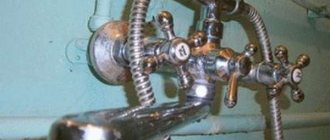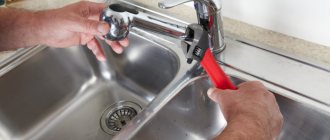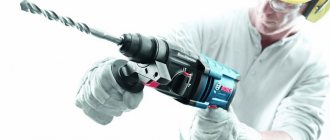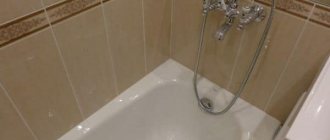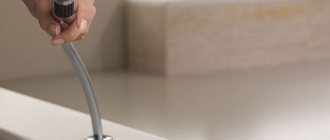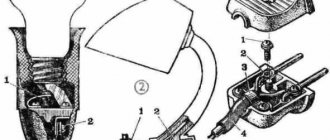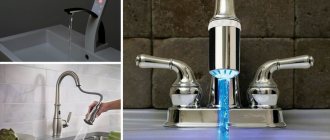Most of us have a single-lever cartridge faucet installed in our kitchens and bathrooms. The cartridge is the main part of the faucet, which is responsible for opening, closing, turning the spout, closing types, the degree of jet intensity, etc. Therefore, as soon as any problems appear in its operation, the mixer cartridge needs to be repaired. The cartridge acts as a shut-off valve, however, this part may leak or fail for another reason. Then it will have to be changed.
Types of cartridges and principle of operation
Since the faucet is the final part in the distribution system, changes in water pressure have a detrimental effect on their moving part. Cartridges that are responsible for supplying liquid at a certain temperature are the first to suffer. That's why they need repairs so often. The Plumber Portal website will tell you how to repair a kitchen faucet, but first you need to find out the important details.
First of all, it is worth saying that there are two types of faucet cartridges:
- ball;
- disk with metal-ceramic plates.
Both types of these cartridges are used in single-lever faucets.
The model using ceramic inserts has become more widespread, although the quality and service life of the ball analogue is no worse.
The main element of the ball cartridge is a hollow ball with three holes: two at the bottom and one at the top. The water is mixed inside the ball when the lever is turned. It fits tightly onto two rubber “saddles” with holes through which cold and hot water flows. Due to the water pressure, leakage is possible only in the event of mechanical interference.
In a disk cartridge, water flows through pipes into the very heart of the mixer, mixes there and then ends up in the spout. Metal-ceramic discs regulate the temperature and pressure of the water jet at the outlet. The crane lever moves the upper disk. When its protrusions fit tightly to the hole of the lower disk, the flow of liquid is blocked. If the upper disk barely covers the lower one, then water begins to flow: the larger the gap, the greater the pressure.
At the same time, the water temperature depends on the degree to which the upper disk blocks access to cold and hot flows.
Since the second type of kitchen faucet with a cartridge is more popular, we will now dwell on it in more detail.
Peculiarities
The main feature of the mixer is its design. Such diversity does not at all mean a big difference in the technical characteristics of the devices: the functional features of most models are unlikely to differ. The only thing you should pay attention to when purchasing is whether the cartridge is replaceable or solid.
Devices with replaceable cartridges are considered convenient and reliable to use. They are usually more expensive, but are in constant demand. An element that can be replaced is advantageous in that it allows you to quickly restore the functionality of the entire device. Normal operation of the device will not be possible if the cartridge is selected incorrectly. Therefore, before purchasing a new part, it is important to understand the characteristics of the device.
It is also important to understand what this part serves. The main task of the cartridge is to mix water at different temperatures. This part is also responsible for the intensity of pressure. It turns out that this element receives the most load. This is why this system most often stops working. If the existing faucet has a replaceable cartridge, replacing the mechanism will not be difficult.
When purchasing a new part, it is worth considering that there are two main mechanisms that can be installed in your mixer: the first option is ball, the second is disk. If the mixer is single-lever, it may contain both the first and second types of devices. If the mixer is two-valve, only the disk version can be inside.
Manufacturers often use disk ceramic cartridges in their devices. These products have practically no advantages over ball types. The products are identical in manufacturing quality and service life. It’s just easier for manufacturers to produce disk cartridges, and they are more practical to manufacture. Let's look at the criteria for choosing a cartridge device in more detail.
Structure of a cartridge disc mixer
This model of faucet with a cartridge is good because they are easy to repair or replace if repair is impossible.
The structure of single-lever disk cartridges with ceramic plates is not complicated. Top down:
- Switch with fixing screw.
- Locking (clamping) nut.
- Cartridge. The water flows are mixed in it, and the same device shuts off the water.
- The mixer body, which has a “seat” for the cartridge.
- Fasteners, studs and gaskets to ensure tightness.
- Spout (gander). It can be a separate part - in rotary models for the kitchen or part of the body - for sinks in the bathroom.
- If the spout is separate, gaskets are also installed below and there is also part of the body.
The disadvantage of a disc cartridge for a single-lever mixer is its high demands on water quality. If even a small foreign fragment gets between the plates, the faucet will leak or stop functioning altogether. In addition, setting the required temperature can sometimes be very difficult.
Basic faults
During the operation of the mixer, malfunctions arise that are associated both with the quality of the water and with incorrect operational features of the plumbing fixture. The axle crane takes on a large load, since water under high pressure passes through it.
If the spare part is of low quality, then after several months of active use the mixer will leak.
Frequent causes of faucet cartridge failure:
- hard water with a high content of salts and mineral scale, which accumulates on the core of the mixer, the cartridge simply “sticks” and becomes coated with plaque;
- pressure differences in water supply. With sudden jumps, the part quickly breaks and bursts;
- If the diameter of the faucet spout does not correspond to the size of the cartridge, then noise and crackling will be heard when water is supplied.
- Lubricate the plates. This will help reduce friction and increase operation. Oily mixtures and sealants are used.
- Adjust the thermostatic cartridge if the device has reset due to frequent use of low-quality water.
- Remove clogs from the threads using an old toothbrush.
Is the faucet with the cartridge leaking? - replacement!
If the mixer is leaking, then you need to tighten the nuts; if this measure obviously does not help, then you need to change it... But what to change depends on the cause of the breakdown.
Situation 1:
The bathroom cartridge faucet has a leak. I disassembled it, replaced the cartridge (35 mm, without legs) - the problem was solved.
Conclusion: The cartridge was indeed faulty, and replacing it solved the problem.
Situation 2:
The faucet (single-lever mixer) in the kitchen began to leak (drip). When I removed the lever from above, the old cartridge was completely filled with water. Well, of course, the old cartridge was leaking. However, after purchasing a new cartridge and installing it, the mixer stopped dripping and out of curiosity, I decided to remove the lever and see if the cartridge was leaking under the lever.
I looked in and saw that there was water there. I returned the cartridge to the store and bought a new one. I checked - the same thing. In short, I tested 4 cartridges in this way - the result was the same. Moreover, if you don’t use a mixer, everything is fine. You start to turn on/adjust/turn off the water, water gradually appears under the lever. Is this normal? How to fix the problem?
Answer from the Plumber Portal website: Of course, you could have received a defective part, but not 4 pieces in a row! The problem most likely lies with the mixer itself. The tap needs to be replaced.
Conclusion: If the fourth cartridge in a row leaks, then the faucet needs to be replaced.
Situation 3:
The cartridge in the faucet in the bathroom began to leak. I changed the part, but a couple of drops still seep out and a 1-2 mm layer of water is always present. The problem manifests itself specifically on the cartridge levers. I thought I was pinching the brass nut that secures the cartridge on top. But even I tried to clamp it very loosely, water still came out. How to repair a faucet?
Answer from the Plumber Portal website: If the problem was in the cartridge, then replacing it would solve the problem, which means the problem is in the mixer. After prolonged use, there is a high probability that micro-sinks have formed in the faucet seat. It will have to be replaced, and the old cartridge, by the way, could be working. It was necessary to try to adjust the fit of the metal-ceramic plates with a fixing screw.
Conclusion: If adjusting the plates does not solve the problem of small leakage, then the cartridge seat may be worn out. It's worth replacing the part. If the cartridge is new, but there is still a small leak, then the tap needs to be replaced.
Thus, having studied all three situations, it becomes clear that if the faucet is leaking and adjusting the plates does not give any result, then either the cartridge or the entire faucet needs to be replaced. In any case, a leaking single-lever faucet is a bad sign.
Instead of replacing parts, repairing a faucet with a disc cartridge sometimes involves reassembling and cleaning the O-rings, on which dirt and debris accumulate and salts are deposited. To eliminate a leak, the faucet must be disassembled, all elements wiped with soapy warm water to remove dirt, rinsed, dried and reassembled. If these measures do not help, then there is no escape from replacement.
Dimensions
Typical dimensions of mechanisms for different devices are divided according to certain standards, which are different for each model. For example, for washbasins or showers, models with standard sizes of 28, 32 or 35 mm have become widespread. Bathroom faucets are most often equipped with cartridges with sizes ranging from 40 to 45 mm. At the same time, the mixers themselves look identical.
One rule applies to almost all mixers: the larger the cartridge, the more efficient it is. Chinese taps (for example, Frap) have large diameter cartridges, as well as a large spout size. At the same time, the large diameter of the cartridge of branded models Fiora, Iddis, Sedal and other options does not always mean quality
Here it is important to pay attention to other technical characteristics of the products. For example, for a high spout, the optimal cartridge diameter is 35–40 mm
How to disassemble the faucet and change the cartridge?
Let's find out how to properly disassemble the faucet and how to replace the cartridge. First of all, you need to turn off the water, and then follow this plan:
- Remove the decorative plug located on the lever. Just pry it off with a screwdriver.
- Behind it is a mounting screw. It needs to be unscrewed using a hex key and removed.
- Now the shift lever must be pulled up.
- Then a decorative washer is screwed onto the body or simply installed. It needs to be removed.
- Unscrew the clamping nut. It has a large diameter, so you may need an adjustable wrench or a set of open-end wrenches.
- Next, you need to remove the cartridge and inspect it.
- Below are gaskets, fasteners and studs. You need to remember exactly the order in which they are laid out. Sometimes it even matters which side they are laid on. Therefore, be careful when disassembling.
- The mixer with the cartridge is disassembled. There aren't many details. The main working part is the cartridge. It is in it, inside, that mixing occurs.
The cartridge itself has a sealing gasket - a rubber seat at the bottom, which ensures a tight fit to the body. Over time, the rubber loses its elasticity and water begins to leak out. If this is the problem, then you can try to clean this ring from the salts and deposits that have formed on it. Put the cleaned part back in place and check the operation. If the leak does not stop, you will have to replace it.
Cartridges for mixers are available in different diameters with different locations of inlets and outlets in the lower part. Therefore, if it is necessary to replace it, you need to disassemble the faucet, remove the part and select an absolutely identical model with it. Then the cartridge needs to be installed in the housing and turned slightly until it feels like it has “sat” in place. Next, you need to reassemble the mixer in reverse order.
First of all, you need to install the clamping nut and you can immediately check the operation of the new part. To do this, you need to turn on the water, adjust the temperature and pressure with the rod. To make it more convenient, you can put a handle on the rod. If everything is fine, continue assembly.
Kinds
As mentioned above, cartridges come in two varieties: disk or ball type. The ceramic disk cartridge is equipped with a plastic housing, and this part can be collapsible or non-removable. If the part is collapsible, then there will be two parts in it, and they will be connected using a rubber seal. The inserts are located in the holes in the lower part. The parts are held together with plastic rivets.
Inside the product there is always a rod, which is also called a leg; the mixer handle is mounted on it. The lower part of the rod is fastened with a ceramic disc-type retainer. These upper disk devices are controlled by the rod. Thus, it has the property of rotating and shifting, while the disk itself remains in a fixed state. The disk is fixed in the lower part of the ceramic body.
If we consider the process of mixing temperatures, it will consist of a certain sequence of actions. So, the holes on the disk devices align when the top disk is turned. In this case, the displacement of the upper disk devices entails a change in the intensity of water pressure. Sooner or later, cartridges, even in the most expensive mechanisms, require repair or replacement. The process of replacing devices is simple, but we’ll look at it in more detail a little later.
A ball-type device looks like a hollow steel ball equipped with interconnecting holes. Usually one of them is output, and two are input. Depending on how the holes are located, the temperature and flow are set. With a larger combined area, water flows more strongly. The temperature of the liquid changes when the nozzles are turned or tilted. Inside the cavities of the reinforcement mechanism, the liquid is mixed.
The ball-type cartridge mechanism often breaks due to accumulated deposits. They form inside an empty ball, causing the smoothness of the mechanism to deteriorate. When operating such a device, the joystick of the single-lever faucet itself may break.
The choice of a ball device should be as scrupulous as in the previous version. The wide range of options for these units presented in retail outlets gives reason to think. Ball mechanisms are usually selected identical to existing standard sizes.
Is the faucet running slow? – lubricate moving parts!
Situation 4:
After two months of use, the cartridge in the kitchen faucet began to creak and jam. The first cartridge lasted a year and was thrown into the trash. This is the water...
Lubricant was purchased along with the second cartridge. I tried smearing the parts of the ceramic washers that are visible in the hot and cold water inlets, but it looks like almost nothing got between the washers. After my manipulations, I began to rotate more easily, but I still feel tension. Can you please tell me how to apply the lubricant correctly?
Answer from the Plumber Portal website:
- Firstly, if you have water that renders plumbing parts unusable within a year, then we advise you to install a filter at the inlet.
- Secondly, the problem may not be a lack of lubrication, but rather pressure. Install the gearbox and you will be happy.
- Thirdly, there is no particular point in lubricating ceramic plates. All other moving parts need to be lubricated - water does not touch them. Perhaps the crane axle box is jammed. Rub the lubricant over the rubbing and rotating parts.
Conclusion: If the tap begins to turn tightly after a while, then you need to lubricate all rubbing and rotating parts. It would be a good idea to install a reducer and a filter at the inlet.
Manufacturers
The market offers a huge range of products from various manufacturers. The mechanisms can be metal or ceramic. The most convenient way is to order the desired mixer in an official online store that sells products from the corresponding manufacturer.
The following brands are popular:
- Oras;
- Damixa;
- Frap;
- Iddis;
- Kludi;
- Blanco;
- Vidima;
- AM. PM.
The most inexpensive models are Chinese: Iddis, Frap. The company offers customers ceramic products suitable for any faucets. Among the advantages, users note reliability and durability. At the same time, few people find disadvantages in these products.
AM models. PM are universal mixers. However, many users consider the high cost of these products to be a disadvantage. In general, the cartridges are rated positively.
Oras models are widely used. This is a Finnish manufacturer that is famous for its good quality parts assembly. However, these products are also inaccessible in terms of cost.
If price is a criterion as important as quality, you can pay attention to Bulgarian products. The corporation offers consumers a wide range of products that will strictly comply with all European standards. At the same time, the price of quality products is not as high as that of a German or Finnish manufacturer.
Models from the following companies have good quality characteristics: Damixa, Kludi, Blanco.
It is better to choose a cartridge for the mixer from the corresponding manufacturer. In this case, you definitely shouldn’t have any problems using the device after repair. To ensure that your faucet repair goes smoothly, please read the installation instructions for the device.
Which cartridge lubricant should I choose?
The problem of the faucet being difficult to operate can be solved by removing the ceramic cartridge and coating the discs inside with lubricant.
Let's look at what types of lubricating compounds are better and what they are:
Tsiatim-221 is a plastic composition made in accordance with GOST. Perfectly suitable for metal parts, rubber, plastic, ceramic, as well as for friction units. This lubricant is often used not only for mixers, but also for bearings in electrical machines and aggregate bearings in aircraft.
The consistency of Ciatim-221 is such that it does not dissolve in water. Resistant chemical composition - provides good lubricating quality, even at a pressure of 600 Pa it is not washed off. Temperature changes from -60 to +150 degrees will also not cause harm to the composition.
Due to its characteristics, Tsiatim-221 is in great demand, so purchasing it is very problematic, and sellers offer a less effective analogue - Tsiatim-201.
Silicone Grease. This composition is used to fill the space between the plates of the ceramic cartridge - the gap is too small, and without lubrication it is impossible to even move the handle from its place. This consumable material softens the rotation of the lever and allows it to be turned freely. If you feel like the lever is sticking when turning, then you need to update the silicone lubricant.
Silicone grease is a white, translucent paste. Do not confuse it with silicone sealant under any circumstances, otherwise the faucet will have to be thrown away. One application of paste should be enough for 50,000 lever revolutions. It is usually sold in auto parts stores and car markets. Price 8-10 dollars.
When applying silicone grease to the top plate, for convenience, the cartridge should be held upside down, but keep in mind that in this position it will be the bottom plate - there is no need to pour it into the holes. Next, you need to distribute it evenly; to do this, rotate the rod in the cartridge. If necessary, you can apply a little more.
If, after applying the composition, sand or rust still gets between the plates, then you need to buy a new cartridge.
RAVAK – Teflon lubricant. It is also insoluble in water, but is washed out over time, so the frequency of the need to lubricate parts increases.
But thanks to the list of advantages, Teflon grease is in demand among consumers:
- wide temperature range - withstands where others fail;
- It is enough to apply one drop on the face - ergonomics;
- its property does not allow it to turn yellow over time, as is usually the case with pastes;
- It can also be used to lubricate door hinges and shower enclosures, shower frames, and door handles.
This information will help you select and apply faucet lubricant correctly to prolong the operation of your plumbing fixtures.
What is needed for repair
To carry out repair work, you will have to disassemble the faucet without removing it from the sink; sometimes you may need to repair the kitchen spout, which in one-handed models can be carried out without disassembly operations.
When dismantling the faucet, you have to remove the handle, unscrew the fixing nuts and hoses - this requires suitable tools, consumables and components.
Tools and supplies for plumbing repair work
Tools
To carry out repair work you will need the following tool:
- An adjustable wrench for unscrewing the nut from the mixing device body and dismantling flexible hoses.
- A socket or flat wrench for tightening and removing bolts on mounting studs.
- A Phillips screwdriver or hex wrench for removing the faucet handle.
Necessary materials
When removing the mixing body from the kitchen sink or removing underwater hoses, you often encounter difficulties associated with contamination of the dismantled parts with limescale or corrosion. Before carrying out work, it is better to treat their surface with household chemicals to remove rust and limescale - this will simplify the dismantling and further installation of the equipment.
The presence of gaskets in the underwater hoses and the mixing body eliminates the use of various types of additional seals in the form of synthetic and linen tape, rubber rings.
During repair work, it is often necessary to replace underwater hoses that have become unusable; for replacement, it is better to purchase types with stainless braiding and a union nut with fittings made of non-ferrous metals (copper, brass).
Internal structure of a single lever cartridge faucet
Practical advice
As you have already seen, the service life of cartridges is greatly influenced by the quality of water, its hardness and the presence of hard impurities - debris, sand, rust, etc.
Sediment, plaque and the presence of foreign particles wear out the plates and seals, which complicates the operation of the lever, leads to leaks or “squeezing”, when the hot flow with excess pressure displaces the cold flow through the cracks formed in the tap.
Experts strongly recommend finding out the composition of the water and the impurities in it and, if necessary, including a cleaning filter at the inlet in the water supply wiring diagram.
Wear and tear also depends on the quality of the products purchased. You shouldn’t save a lot, as this can ultimately result in much larger expenses not only for repairing the faucet cartridge, but also for your and your neighbors’ bathroom or kitchen.
General information. Pros of single-lever devices
Attention! The kitchen faucet, which regulates the water supply using a single lever, has a simple design, a high degree of functionality, durability, and the tap is easy to operate.
Mixers of this type are quickly gaining popularity because they have many positive qualities. These include simplicity and the ability to repair. The device is easy to use; to open or close the tap, you just need to raise or lower the lever. To regulate the temperature of the liquid, the joystick must be turned to the sides; the pressure is adjusted by moving the lever up and down. The mixer consists of a small number of elements, so it breaks less often. When a cleaning filter is installed on the mixer, the device can operate for over ten years. Mixers made from high-quality material have this property.
Attention! Faucets made of fragile silumin are inexpensive, but these devices will not last long.
A single lever faucet is easy to repair for anyone new to plumbing. As a rule, repairs consist of replacing the cartridge or ball. This depends on the type of device.
If the lever goes down on its own
Spontaneous lowering of the mixer lever usually tells us that it is broken. When you press the flag, water may flow in a thin stream or not at all. Many people believe that the main reason for this lever behavior is a cartridge failure, but this is not always the case.
All residents of a city apartment or country house use plumbing differently. Some open the taps carefully, others, for example, children, jerk the flag sharply. In the latter case, damage to the inner part of the lever, which fits onto the head of the cartridge, may occur. If damaged, the walls of the square insert diverge to the sides, which leads to a certain amount of free movement of the part; when lifted up, the crane begins to fall.
Note! To determine the breakdown, you need to remove the round decorative insert, unscrew the screw and remove the lever. After this, they look at the inside of the flag: if it is damaged, then install a similar part from the old mixer. If you have high-quality plumbing, lowering of the lever may be caused by wear of the cartridge, which will need to be replaced.
The first possible cause of leakage
There is already a real fastener underneath. This is the clamping nut that holds the cartridge in the housing.
If you look through the prism of failure, this is the first possible cause of leakage from under the handle. If the nut is loose or unscrewed even a little, then there will not be enough force to hold the cartridge in the socket, which is why water seeps behind the cartridge and finds its way out under the handle.
We try to tighten the nut. Perhaps by turning the nut at least a quarter turn, you will be able to clamp the cartridge. But the main thing at this stage is not to overdo it. It's rare that a faucet has this nut made of good material. It may burst under excess load. It will be difficult to get the same one, since it is not considered a consumable item and manufacturers do not sell such spare parts separately.
We try to tighten the nut; it is advisable to use a spanner wrench; it distributes the load across all faces and reduces the likelihood of damage. If you feel that the nut is tightened completely and cannot be turned any further, then do not try. In this case, you need to unscrew the nut to get to the second possible cause of leakage from under the handle - the cartridge.
A ceramic cartridge is a system of two ceramic plates enclosed in a housing.
By adjusting the placement of the plates relative to each other with the handle, we increase or decrease the gaps of the input channels and adjust the flow intensity on the output channel. If the cartridge body cracks, this leads to a leak in the mixer.
There is only one way out - replace the cartridge with a new one. But when purchasing, take into account the fit of the cartridge, which may differ, as well as the diameter of the cartridge itself. It is best to remove the old one before purchasing a cartridge and go to the store with it. This will reduce the chance of a repeat run.
A common problem with cartridges is the case when the movement of the handle is complicated. Low-quality cartridges have plates made of plastic coated with graphite lubricant, which washes out over time and the soft plastic becomes damaged. Without good sliding, the plates lock and the handle becomes increasingly difficult to move. If this problem occurs, replace the cartridge.
If all of the above recommendations are followed, the leak under the handle will be eliminated. If the handle did not leak initially, we disassemble the mixer further. Our goal in this case is to get to the body seals.
How to disassemble the case
To unscrew the mixer body itself, just unscrew the stand on which the mixer stands.
Now the rotating spout is supported only by seals. We carefully pull it down, turning it back and forth a little. By removing the spout, you can see the most likely cause of housing leakage - the seals. There are two seals in total - upper and lower.
If any of them is damaged, water is able to escape from the mixing chamber to the outside. In order to remove the seal, you need to pry it off with a thin screwdriver.
Such seals are sold in stores and if you find damage to them, you should replace them without hesitation. Most likely, after replacing the damaged elements, the leak will be eliminated.
We assemble the mixer in the reverse order from that shown. Before installing it on the sink, it is advisable to screw the hoses to the mixer and supply water to make sure there are no leaks. If all is well, install the mixer, reconnect the hoses and use it.
